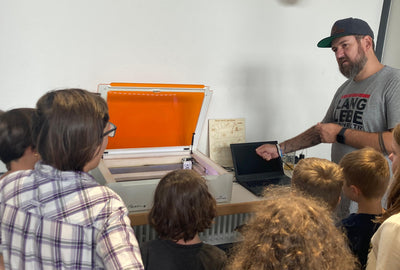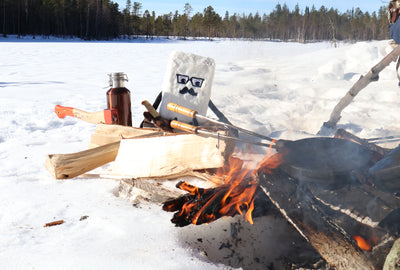Today we introduce you to the student research centre at the Bissendorf location.
The Student Research Center
Hello Malte, thank you very much for taking your time and answering our questions. Please briefly introduce yourself and the inclusive student research centre
In the high school at Sonnensee we have established the student research centre in collaboration with the University of Osnabrück and the Osnabrück University of Applied Sciences. This extracurricular offer offers modern equipment and the first-class specialist knowledge of all network members. An optimal learning environment is created through an intensive exchange of experiences. Our maker space enables students to develop and implement their own projects. We attach great importance to the fact that everyone is welcome here, regardless of their parents' background, gender or financial resources.
Pursue goals together
What does MINTclusion stand for and what goals do you pursue with it?
MINTclusion is the combination of MINT and inclusion. We want to create an offer or a space in which everyone can realize themselves and develop their potential, regardless of their origin, disability, socioeconomic status or gender. The MINT area offers many different approaches and opportunities. The diversity of our participants should be reflected in the diversity of the projects. The shortage of skilled workers, which will only increase in the coming years, makes it necessary for MINT to be spread across society. With us, entry is low-threshold and everyone decides independently how and when the level of complexity is increased. We do not evaluate the projects, we only support the planning and implementation. In addition, where possible, we continually reduce our active presence in the foreground so that the kids help each other. At Mr Beam, for example, I was just able to instruct one participant to the point where he is now able to accompany other kids on simple laser and engraving projects.
Mr Beam as support in the research centre

How did you become aware of Mr Beam and which model do you use?
We became aware of Mr Beam through a colleague from another school. We use the Mr Beam II dreamcut with the Air Filter II (now of course with the height extension and the cutting frame).
Why is the Mr Beam Height Extension so useful for you as an extension?
The height extension is currently necessary for us because we engrave larger wooden objects. For example, we recently constructed an Advent wreath out of wood by first sawing four square wooden blocks at different heights and then milling a hole (for a tea light) in each wooden block. The numbers from 1 to 4 were then engraved on the wooden blocks. Overall, the Height Extension expands our spectrum and offers the kids even more opportunities to implement their own projects.

How is the Mr Beam received by the children, and what materials do you mainly use?
The kids love Mr Beam. In the beginning, breakfast boards were mainly engraved for friends and family. People now create their own SVGs with Inkscape and laser cut Christmas decorations or similar. One participant now begins to construct and laser their own wooden boxes. The Mr Beam is very beginner-friendly (especially due to the browser-based interface) and yet offers enormous, even complex, possibilities as the learning curve increases. We laser and engrave primarily wood (birch/poplar plywood, bamboo or solid wood), but have also experimented with anodized aluminium and leather.
A variety of impressive school projects

What projects do you implement in the research centre? Do you have any concrete examples for us?
Our students are involved in a variety of projects that promote their creative and technical skills. This includes making a remote-controlled car, building an impressive marble roller coaster, preparing for the World Robot Olympics with the mBot2 and laser-cutting a wide variety of wooden objects, from boxes to pen holders. They use the Mr Beam to creatively design breakfast boards made of bamboo and put their programming and construction skills to use with Lego Spike.
The projects also include various woodwork such as the production of tool boxes, individual lamps with LED lighting and 3D printing projects. We even cooperate with JugendForscht by using filament made from PET bottles and enthusiastically take part in the Solar Cup race. The variety of projects not only reflects the commitment of our students, but also the wide range of opportunities that our student research centre offers.
What other technical aids do you use?
We currently have a wide range of technical tools that bring creative ideas to life. This includes not only 3 CAD mills, but also an impressive fleet of 18 3D printers, including a continuous 3D printer that offers innovative possibilities. They also have 8 robots at their disposal, which are small, versatile helpers in their school projects.
In our well-equipped wood workshop you will find various wood processing machines such as belt sanders, panel saws and drill presses, which enable you to carry out your wood projects precisely.
This is complemented by a modern IT infrastructure with computers and iPads, which offer students comprehensive access to digital resources and programming tools. These technical aids are crucial support elements in order to best develop the creative potential of our young people.
School projects in the future
Is there a larger project that you would like to implement with the children in the future?
We definitely want to expand our design options and get a second Mr Beam. Under the name "Woodbox" we plan the construction and laser cutting of various wooden boxes, from simple containers to pen holders and toolholders. A particularly exciting project is the collaboration with the newly founded student company "Die Makerschmiede" from OBS Bissendorf as part of the "Die Makerschmiede" project.
In addition, with the project “From Bissendorf to the World” we would like to construct and laser-cut wooden postcards as part of the anniversary celebration “50 Years of Bissendorf” that will be sent to our students’ countries of origin.
Another ambitious project that we call “Plastic Heroes” is to recycle plastic lids and similar materials. This is done using a shredder, an injection moulding machine and an extruder to make your own products. These future projects represent not only innovative technologies, but also our commitment to promoting sustainable and creative approaches in our student research centre community.
Thank you very much, Malte. The insight was very interesting for us, and we wish you much joy and success in your future work!



